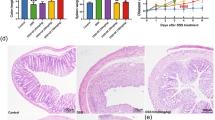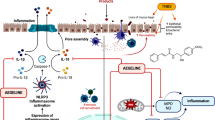Abstract
Objective
To elucidate the underlying mechanism of Panax notoginseng saponin (PNS) on gastric epithelial cell injury and barrier dysfunction induced by dual antiplatelet (DA).
Methods
Human gastric mucosal epithelial cell (GES-1) was cultured and divided into 4 groups: a control, a DA, a PNS+DA and a LY294002+PNS+DA group. GES-1 apoptosis was detected by flow cytometry, cell permeability were detected using Transwell, level of prostaglandins E2 (PGE2), 6-keto-prostaglandin F1α (6-keto-PGF1α) and vascular endothelial growth factor (VEGF) in supernatant were measured by enzyme linked immunosorbent assay (ELISA), expression of phosphatidylinositide 3-kinase (PI3K), phosphorylated-PI3K (p-PI3K), Akt, phosphorylated-Akt (p-Akt), cyclooxygenase-1 (COX-1), cyclooxygenase-2 (COX-2), glycogen synthase kinase-3β (GSK-3β) and Ras homolog gene family member A (RhoA) were measured by Western-blot.
Results
DA induced apoptosis and hyper-permeability in GES-1, reduced supernatant level of PGE2, 6-keto-PGF1α and VEGF (P<0.05). Addition of PNS reduced the apoptosis of GES-1 caused by DA, restored the concentration of PGE2, 6-keto-PGF1α and VEGF (P<0.05). In addition, PNS attenuated the alteration of COX-1 and COX-2 expression induced by DA, up-regulated p-PI3K/p-Akt, down-regulated RhoA and GSK-3β. LY294002 mitigated the effects of PNS on cell apoptosis, cell permeability, VEGF concentration, and expression of RhoA and GSK-3β significantly.
Conclusions
PNS attenuates the suppression on COX/PG pathway from DA, alleviates DA-induced GES-1 apoptosis and barrier dysfunction through PI3K/Akt/ VEGF-GSK-3β-RhoA network pathway.
Similar content being viewed by others
References
Costa F, Van Klaveren D, Feres F, James S, Raber L, Pilgrim T, et al. Dual antiplatelet therapy duration based on ischemic and bleeding risks after coronary stenting. J Am Coll Cardiol 2019;73:741–754.
Shaukat A, Waheed S, Alexander E, Washko D, Gupta K. Etiology of gastrointestinal bleeding in patients on dual antiplatelet therapy. J Dig Dis 2018;19(2):66–73.
Lanas A, Garcia-Rodriguez LA, Arroyo MT, Gomollon F, Feu F, Gonzalez-Perez A, et al. Risk of upper gastrointestinal ulcer bleeding associated with selective cyclo-oxygenase-2 inhibitors, traditional non-aspirin non-steroidal anti-inflammatory drugs, aspirin and combinations. Gut 2006;55:1731–1738.
Yusuf S, Zhao F, Mehta SR, Chrolavicius S, Tognoni G, Fox KK, et al. Effects of clopidogrel in addition to aspirin in patients with acute coronary syndromes without ST-segment elevation. New Engl J Med 2001;345:494–502.
Shim YK, Kim N. Nonsteroidal anti-inflammatory drug and aspirin-induced peptic ulcer disease. Korean J Gastroenterol 2016;67:300–312.
Zeisel MB, Dhawan P, Baumert TF. Tight junction proteins in gastrointestinal and liver disease. Gut 2019;68:547–561.
Citi S, Paschoud S, Pulimeno P, Timotali F, Robertis FD, Jond L, et al. The tight junction protein cingulin regulates gene expression and RhoA signaling. Ann New York Acad Sci 2009;1165:88–98.
Oshima T, Miwa H, Joh T. Aspirin induces gastric epithelial barrier dysfunction by activating p38 MAPK via claudin-7. Am J Physiol Cell Physiol 2008;295:C800–806.
Kitay AM, Ferstl FS, Link A, Geibel JP. Induction of secretagogue independent gastric acid secretion via a novel aspirin-activated pathway. Front Physiol 2019;10:1264.
Luo JC, Huo TI, Hou MC, Lin HY, Li CP, Lin HC, et al. Clopidogrel delays gastric ulcer healing in rats. Eur J Pharm 2012;695:112–119.
Wu HL, Gao X, Jiang ZD, Duan ZT, Wang SK, He BS, et al. Attenuated expression of the tight junction proteins is involved in clopidogrel-induced gastric injury through p38 MAPK activation. Toxicology 2013;304:41–48.
Wu F, Chen Z, Tang C, Zhang JJ, Wei XJ. Acid fibroblast growth factor preserves blood-brain barrier integrity by activating the PI3K-Akt-Rac1 pathway and inhibiting RhoA following traumatic brain injury. Am J Transl Res 2017;9:910–925.
Wang WT, Xue M, Yang L, Song L, Li CK, Yang B, et al. Experimental research on the protective effect of Panax notoginseng saponins on the gastric mucosa and the anti-platelet effect of aspirin based on arachidonic acid metabolic pathway. Chin J Integr Med Cardio-/Cerebrovasc (Chin) 2019;017:1315–1320.
Shi X, Zhao F, Dai X, Dong X, Fang J, Yang H. Effects of san qi on gastric secretion and protective factors of gastric mucosa in the rat with precancerous lesion of stomach. J Tradit Chin Med 2003;3:220–224.
Shen K, Ji L, Gong C, Ma Y, Yang L, Fan Y, et al. Notoginsenoside Ft1 promotes angiogenesis via HIF-1alpha mediated VEGF secretion and the regulation of PI3K/AKT and Raf/MEK/ERK signaling pathways. Biochemi Pharmacol 2012;84:784–792.
Huang XP, Tan H, Chen BY, Deng CQ. Combination of total Astragalus extract and total Panax notoginseng saponins strengthened the protective effects on brain damage through improving energy metabolism and inhibiting apoptosis after cerebral ischemia-reperfusion in mice. Chin J Integr Med 2017;23:445–452.
Li C, Li Q, Liu YY, Wang MX, Pan CS, Yan L, et al. Protective effects of notoginsenoside R1 on intestinal ischemia-reperfusion injury in rats. Am J Physiol Gastrointest Liver Physiol 2014;306:G111–122.
Zhu D, Liu M, Yang Y, Ma L, Jiang Y, Zhou L, et al. Ginsenoside Rd ameliorates experimental autoimmune encephalomyelitis in C57BL/6 mice. J Neurosci Res 2014;92:1217–1226.
Wallace JL. Prostaglandins, NSAIDs, and gastric mucosal protection: why doesn’t the stomach digest itself? Physiol Rev 2008;88:1547–1565.
Laine L, Takeuchi K, Tarnawski A. Gastric mucosal defense and cytoprotection: Bench to bedside. Gastroenterology 2008;135:41–60.
O’Neill GP, Ford-Hutchinson AW. Expression of mRNA for cyclooxygenase-1 and cyclooxygenase-2 in human tissues. FEBS Letters 1993;330:156–160.
Shinji Y, Tsukui T, Tatsuguchi A, Shinoki K, Kusunoki M, Suzuki K, et al. Induced microsomal PGE synthase-1 is involved in cyclooxygenase-2-dependent PGE2 production in gastric fibroblasts. Am J Physiol Gastrointest Liver Physiol 2005;288:G308–G315.
Banerjee D, Fernandez HR, Patil PB, Premaratne P, Quiding-Jarbrink M, Linden SK. Epithelial MUC1 promotes cell migration, reduces apoptosis and affects levels of mucosal modulators during acetylsalicylic acid (aspirin)-induced gastropathy. Biochem J 2015;465:423–431.
Cheng Y, Lin J, Liu J, Wang Y, Yan W, Zhang M. Decreased vascular endothelial growth factor expression is associated with cell apoptosis in low-dose aspirin-induced gastric mucosal injury. Am J Med Sci 2015;349:110–116.
Luo JC, Peng YL, Chen TS, Huo, TL, Hou MC, Huang HC, et al. Clopidogrel inhibits angiogenesis of gastric ulcer healing via downregulation of vascular endothelial growth factor receptor 2. J Formos Med Assoc 2016;115:764–772.
Sun Z, Liu H, Yang Z, Shao D, Zhang W, Ren Y, et al. Intestinal trefoil factor activates the PI3K/Akt signaling pathway to protect gastric mucosal epithelium from damage. Int J Oncol 2014;45:1123–1132.
Cheng YT, Lu CC, Yen GC. Beneficial effects of Camellia Oil (Camellia oleifera Abel.) on hepatoprotective and gastroprotective activities. J Nutr Sci Vitaminol 2015;61 Suppl:S100–102.
Strachna O, Torrecilla D, Reumann MK, Serganova I, Kim J, Gieschler S, et al. Molecular imaging of expression of vascular endothelial growth factorα (VEGFα) in femoral bone grafts transplanted into living mice. Cell Transplantation 2014;23:901–912.
Wang B, Yang Q, Bai WW, Xing YF, Lu XT, Sun YY, et al. Tongxinluo protects against pressure overload-induced heart failure in mice involving VEGF/Akt/eNOS pathway activation. PLoS One 2014;9:e98047.
Pap M, Cooper GM. Role of glycogen synthase kinase-3 in the phosphatidylinositol 3-kinase/Akt cell survival pathway. J Biol Chem 1998;273:19929–19932.
Osada T, Watanabe S, Tanaka H, Hirose M, Miyazaki A, Sato N. Effect of mechanical strain on gastric cellular migration and proliferation during mucosal healing: role of Rho dependent and Rac dependent cytoskeletal reorganisation. Gut 1999;45:508–515.
Gu YT, Xue YX, Wang YF, Wang JH, ShangGuan QR, Zhang JX, et al. Role of ROS/RhoA/PI3K/PKB signaling in NS1619-mediated blood-tumor barrier permeability increase. J Mol Neurosci: MN 2012;48:302–312.
Author information
Authors and Affiliations
Contributions
Prof. Shi DZ and Dr. Jiang HY have made substantial intellectual contributions to the conception and design of this study, with revising and final approve of the article. Wang MM has contributed to the experiment conduction and data analysis of this study, and the article drafting. Assoc. Prof. Xue M has contributed to the drug material supply and blood sampling and FACS procession. Dr. Xin ZH has contributed to the data analysis. Dr. Li RJ and Wang YH have made substantial contribution to the language revision. All the authors approve the submission and publication of the manuscript.
Corresponding author
Ethics declarations
The authors declare no competing financial interests.
Additional information
Supported by the National Natural Science Foundation of China (No. 81273933 and 81102722), the Eleven Five-Year Plan of National Science and Technology Support Project (No. 2006BAI04A01-2), the Jilin Province Major Science and Technology Achievement Transforming Project (No. 11ZDZH005)
Rights and permissions
About this article
Cite this article
Wang, Mm., Xue, M., Xin, Zh. et al. Panax Notoginseng Saponin Attenuates Gastric Mucosal Epithelial Cell Injury Induced by Dual Antiplatelet Drugs through COX and PI3K/Akt/ VEGF-GSK-3β-RhoA Network Pathway. Chin. J. Integr. Med. 27, 819–824 (2021). https://doi.org/10.1007/s11655-021-2854-3
Accepted:
Published:
Issue Date:
DOI: https://doi.org/10.1007/s11655-021-2854-3




